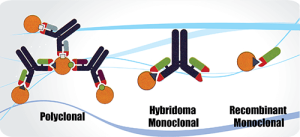
All forms of antibodies, polyclonal, hybridoma-based monoclonal, and recombinant monoclonal have both pros and cons as research tools.
The polyclonal antibodies display multi-epitope binding properties. However, the polyclonal antibodies could present variations in antibody performance. The monoclonal exhibit precise and reproducible binding properties from batch to batch. The recombinant monoclonal offers specificity and reproducibility and do not suffer from clonal drift or gene deletion. However, monoclonal antibodies are costly to produce.
- Multi-epitope binding.
The polyclonal antibody is an invaluable research tool if the antibodies are developed, and validated with the correct specifications. The polyclonal antibodies allow the binding of multiple antigenic determinants of the target. This enables polyclonal antibodies to be more sensitive with more excellent stability. The various binding of several different epitopes will make it more successfully bind a specific antigen in different immunoassays. For example, it is more effective at detecting a target for chromatin immunoprecipitation. The polyclonal antibody is a better option for many test conditions because their multi-epitope binding allows for antigen recognition even if some epitopes are affected by changes in an antigen’s tertiary structure or accessibility. However, the monoclonal antibody may have its epitope buried. Due to multi-epitope binding, it is more visible to use the polyclonal antibody for the western blotting experiment. - High stability.
The polyclonal antibody is a mixture of antibodies with different biophysical attributes, such as charge and hydrophobicity. They are more resistant to changes in temperature and pH when compared with monoclonal antibodies. Usually, it is required to have stabilizing agents to prevent aggregation, and precipitation and preserve antibody binding for the storage of monoclonal antibodies. - A wide range of host animals.
The polyclonal antibody can be generated in a wide range of host animals including rabbits, rats, mice, chickens, ducks, goats, sheep, donkeys, or even horses. The applications are flexible such as the quantity of the antigen, the injection methods and sites, the choice of adjuvants, and the duration of immunization schedules. The large animals with greater total blood volume will produce large amounts of antibodies over time because of the increased serum yield and the animals’ longevity. - Disadvantages.
- Limited supply. This can be solved if the protocol is closely followed to guarantee reproducibility.
- Cross-reactivity. This can be eliminated by negative absorption during affinity purification on a column containing the immunogens. The peptide antibody is especially valuable because of the specific immunogens with known sequences. The phosphor-peptide antibody production will go through the double screening process. First, the antisera would go through the non-phosphor-peptide column to remove the unwanted impurities. The elution will then go through the phosphor-peptide column for specific binding. Lot-to-lot consistency can be effectively managed and controlled by comparing the existing lots to historical lots.
